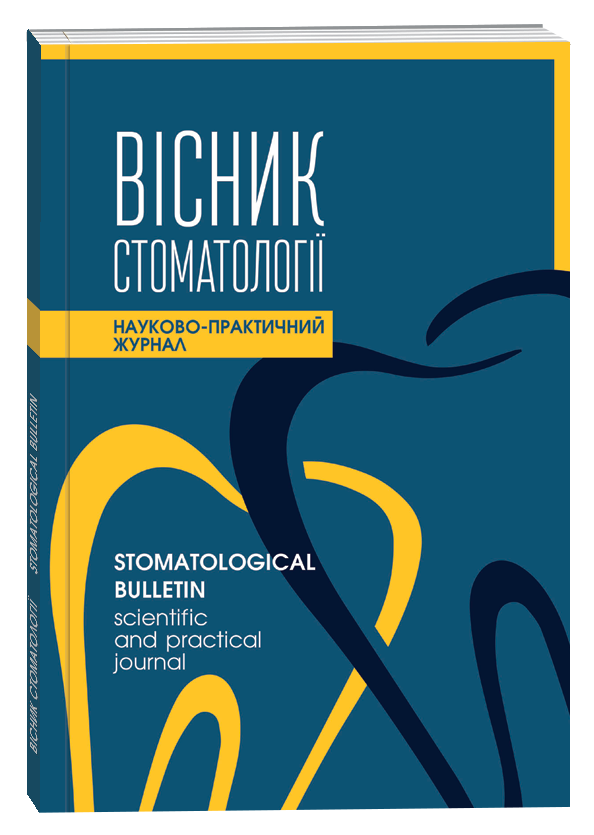CLARIFICATION OF CLINICAL DATA IN CHILDREN WITH CONGENITAL COMBINED UNILATERAL CLEFT OF THE UPPER LIP AND PALATE
DOI:
https://doi.org/10.35220/2078-8916-2023-50-4.7Keywords:
congenital cleft, upper lip, palate, children, cheiloplasty.Abstract
Children with unilateral congenital combined cleft upper lip and palate account for about 50 % of all children born with cleft upper lip and palate. That is, the number of such children born in Ukraine and other countries is sufficient. The purpose of our work. Study of clinical data in this category of patients and, based on them, establish indications for cheiloplasty. Materials and methods. We examined 52 patients with congenital combined cleft upper lip and palate. Of these, 30 are boys and 22 are girls, which is 57.7% and 42.3%, respectively. There were 38 patients with left – sided combined cleft upper lip and palate, and 14 with right-sided cleft lip, which is 75% and 27%, respectively. In 38 children with congenital unilateral combined cleft of the upper lip, out of 52 patients, the cleft was complete, that is, in these 38 patients, the lip defect passed from the free edge of the upper lip (red border of the lip) and crossed the bottom of the nasal passage in the upper part of the lip. In these patients, the defect had a trapezoidal shape, fragments of the lip were raised up after the edges of this defect. The medial (larger) fragment and lateral (smaller) fragment were reduced in height and aligned with the healthy side filter roller. In this group of children, in addition to the defect and deformation of fragments of the upper lip, there is a deformation of fragments of the cellular process, and there is also a fairly pronounced deformity of the nose, which is caused by a defect in the bone tissue of the upper jaw, the bottom of the nasal opening, and soft tissues of the lip. Research results. In this study, we clarified the clinical and some anthropometric parameters of upper lip and nasal and collarbone tissues in children with unilateral congenital cleft upper lip and palate. In other words, we considered local indicators that affect the implementation of surgical interventions in one volume or another. Children with unilateral congenital cleft of the upper lip and palate who have an incomplete cleft of the upper lip and do not have a defect in the cellular process or it is insignificant need cheiloplasty surgery. Children with this type of Pathology who have a complete cleft upper lip and a complete defect of the cellular process need other surgical intervention. Conclusions. Based on clinical and anthropometric studies, we found that 82.7% of children with congenital cleft upper lip and palate had a cleft upper lip, collarbone, bottom of the nasal cavity, and palate. 2. 17.3% of children with the same pathology had a complete cleft upper lip, a partial cleft collarbone, and a complete cleft palate. 3. The first shows cheiloplasty surgery with periosteoplasty of the cellular process and anterior part of the bottom of the nasal gait, the second shows only cheiloplasty.
References
Харьков Л.В. Клініко-хіріругічна класифікація вроджених розщілин верхньої губи і піднебіння. Вісник стоматології. 2009. № 2. С. 36-41.
Delaire J. Theoretical principles and technique of functional closure of the lip and nasal aperture. Journal of Maxillofacial Surgery. 1978. Vol.6. Р. 109-116.
Millard D.R. A primary camouflage of the unilateral harelook. Transactions of the 1st International Congress of the Plastic surgery. Stockholm, Baltimore. 1957. P. 160-166.
Allori A.C., Mulliken J.B., Meora JG., Shugterman S., Marcus J.R. Classification of the cleft lip palate: then and now. Cleft Palate Craniofacial Journal. 2015. Vol.54. № 2. P. 175-188.
Pons-Bonals, A., Pons-Bonals L., Hidalgo-Martínez S.-M., Sosa-Ferreyra C. F. Clinicalepidemiological study in children with cleft lip palate in a secondary-level hospital. Boletín Médico del HospitalInfantil de México. 2017. V. 74. № 2. Р. 107-121 doi: 10.1016/j.bmhime.2017.11.019/
Харьков Л. В., Яковенко Л. М., Вишпінський І. М. Класифікація вроджених незрощень верхньої губи і піднебіння (огляд літератури). Вісник стоматології. 2009. № 3. С. 107-113.









